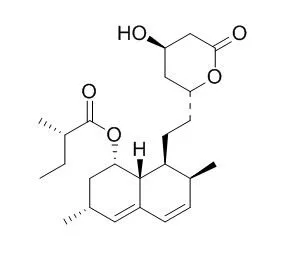| In vitro: |
| Neuroscience. 2015 May 21;294:14-20. | | Lovastatin suppresses the aberrant tau phosphorylation from FTDP-17 mutation and okadaic acid-induction in rat primary neurons.[Pubmed: 25770969] | Statins are a class of cholesterol-lowering drugs and have been suggested therapeutic use for neurodegenerative diseases including Alzheimer's disease (AD). Our recent studies revealed a neuronal protective effect of Lovastatin (LOV) from N-methyl-d-aspartic acid (NMDA) excitotoxicity. The neuroprotective mechanism of statins, however, is far unknown.
METHODS AND RESULTS:
Here we demonstrated that LOV suppressed the aberrant tau phosphorylation both from frontotemporal dementia and Parkinsonism linked to chromosome 17 (FTDP-17) mutation and okadaic acid (OA) induction in cultured rat primary neurons. The protective effect of LOV occurred at multiple pathological sites of tau protein, including Tyr181, Tyr231 Ser202/Tyr205, Tyr212/Ser214 and Ser396/Ser404. Further analysis revealed that the potential mechanism of the suppressive effect of LOV resulted from two aspects, activating OA-inhibited protein phosphatase 2A (PP2A) activity and attenuating OA-induced activity of tau kinases CDK5/P25 and CDK2/4, but not glycogen synthase kinase 3β (GSK3β).
CONCLUSIONS:
These findings give new insights into the molecular mechanism of LOV-mediated neuroprotective effect and provide experimental evidence for its therapeutic use in AD. |
|
| In vivo: |
| Am J Pathol. 2015 Apr 2. | | Prevention of Phenytoin-Induced Gingival Overgrowth by Lovastatin in Mice.[Pubmed: 25843680] | Drug-induced gingival overgrowth is caused by the antiseizure medication phenytoin, calcium channel blockers, and ciclosporin. Characteristics of these drug-induced gingival overgrowth lesions differ.
METHODS AND RESULTS:
We evaluate the ability of a mouse model to mimic human phenytoin-induced gingival overgrowth and assess the ability of a drug to prevent its development. Lovastatin was chosen based on previous analyses of tissue-specific regulation of CCN2 production in human gingival fibroblasts and the known roles of CCN2 in promoting fibrosis and epithelial to mesenchymal transition. Data indicate that anterior gingival tissue overgrowth occurred in phenytoin-treated mice based on gross tissue observations and histomorphometry of tissue sections. Molecular markers of epithelial plasticity and fibrosis were regulated by phenytoin in gingival epithelial tissues and in connective tissues similar to that seen in humans. Lovastatin attenuated epithelial gingival tissue growth in phenytoin-treated mice and altered the expressions of markers for epithelial to mesenchymal transition. Data indicate that phenytoin-induced gingival overgrowth in mice mimics molecular aspects of human gingival overgrowth and that Lovastatin normalizes the tissue morphology and the expression of the molecular markers studied. Data are consistent with characterization of phenytoin-induced human gingival overgrowth in vivo and in vitro characteristics of cultured human gingival epithelial and connective tissue cells.
CONCLUSIONS:
Findings suggest that statins may serve to prevent or attenuate phenytoin-induced human gingival overgrowth, although specific human studies are required. | | J Am Soc Nephrol. 2000 Jan;11(1):80-7. | | Lovastatin inhibits transforming growth factor-beta1 expression in diabetic rat glomeruli and cultured rat mesangial cells.[Pubmed: 10616843] | Diabetic nephropathy is a leading cause of end-stage renal disease and is characterized by excessive deposition of extracellular matrix (ECM) proteins in the glomeruli. Transforming growth factor-beta (TGF-beta) is the major mediator of excessive accumulation of ECM proteins in diabetic nephropathy through upregulation of genes encoding ECM proteins as well as downregulation of genes for ECM-degrading enzymes. It has been shown that Lovastatin, an inhibitor of 3-hydroxy3-methylglutaryl CoA reductase, delays the onset and progression of different models of experimental nephropathy.
METHODS AND RESULTS:
To evaluate the effect of Lovastatin on the development and progression of diabetic nephropathy, streptozotocin-induced diabetic rats were studied for 12 mo. In untreated diabetic rats, there were significant increases in blood glucose, urine albumin excretion, kidney weight, glomerular volume, and TGF-beta1 mRNA expression in the glomeruli compared with normal control rats treated with citrate buffer only. Treatment with Lovastatin in diabetic rats significantly suppressed the increase in urine albumin excretion, kidney weight, glomerular volume, and TGF-beta1 mRNA expression despite high blood glucose levels. To elucidate the mechanisms of the renal effects of Lovastatin, rat mesangial cells were cultured under control (5.5 mM) or high (30 mM) glucose with Lovastatin alone, mevalonate alone, or with both. Under high glucose, TGF-beta1 and fibronectin mRNA and proteins were upregulated. These high glucose-induced changes were suppressed by Lovastatin (10 micro/M) and nearly completely restored by mevalonate (100 microM).
CONCLUSIONS:
These results suggest that Lovastatin has a direct cellular effect independent of a cholesterol-lowering effect and delays the onset and progression of diabetic nephropathy, at least in part, through suppression of glomerular expression of TGF-beta1. |
|






 Cell. 2018 Jan 11;172(1-2):249-261.e12. doi: 10.1016/j.cell.2017.12.019.IF=36.216(2019)
Cell. 2018 Jan 11;172(1-2):249-261.e12. doi: 10.1016/j.cell.2017.12.019.IF=36.216(2019) Cell Metab. 2020 Mar 3;31(3):534-548.e5. doi: 10.1016/j.cmet.2020.01.002.IF=22.415(2019)
Cell Metab. 2020 Mar 3;31(3):534-548.e5. doi: 10.1016/j.cmet.2020.01.002.IF=22.415(2019) Mol Cell. 2017 Nov 16;68(4):673-685.e6. doi: 10.1016/j.molcel.2017.10.022.IF=14.548(2019)
Mol Cell. 2017 Nov 16;68(4):673-685.e6. doi: 10.1016/j.molcel.2017.10.022.IF=14.548(2019)